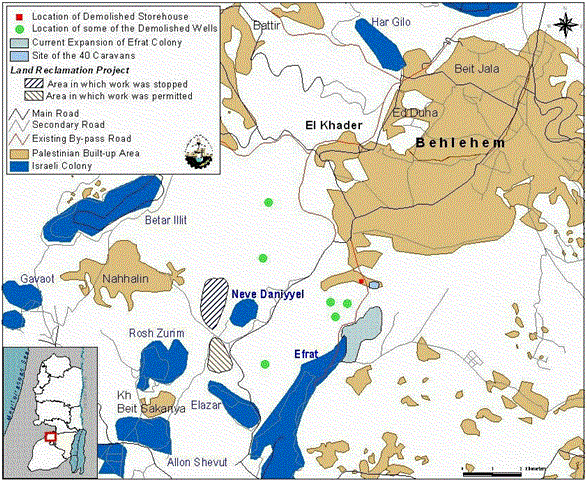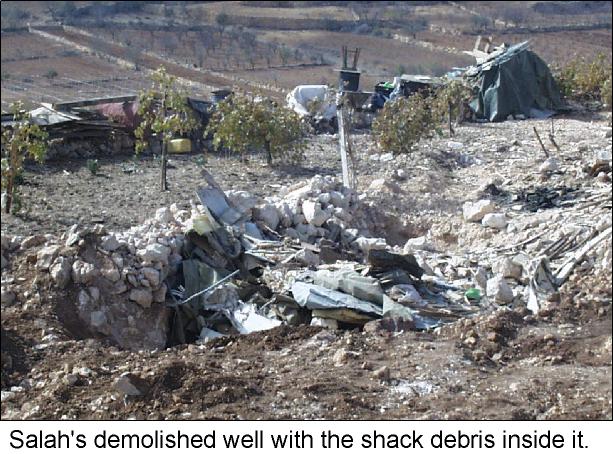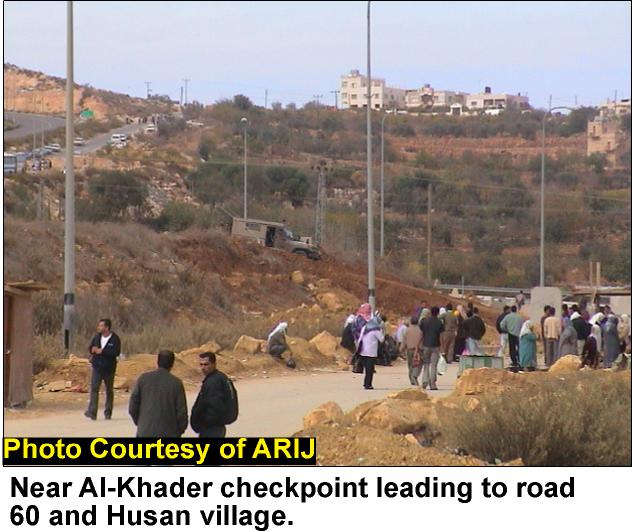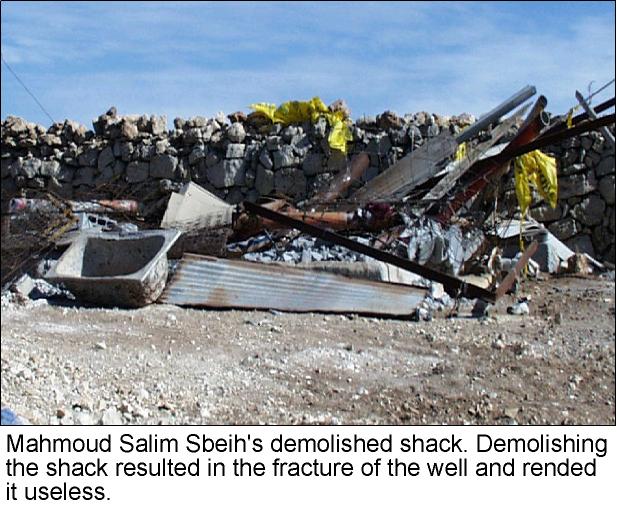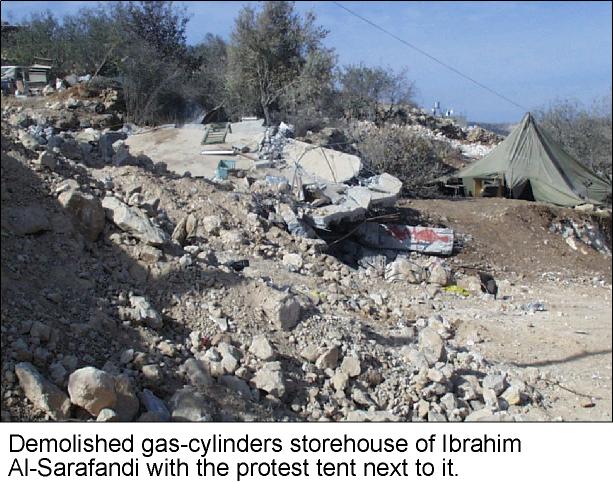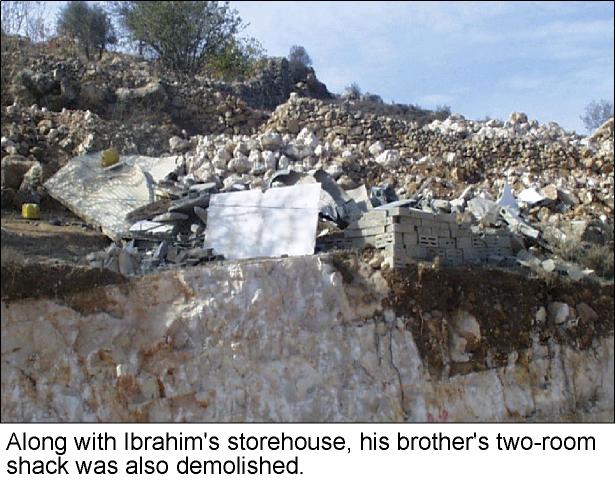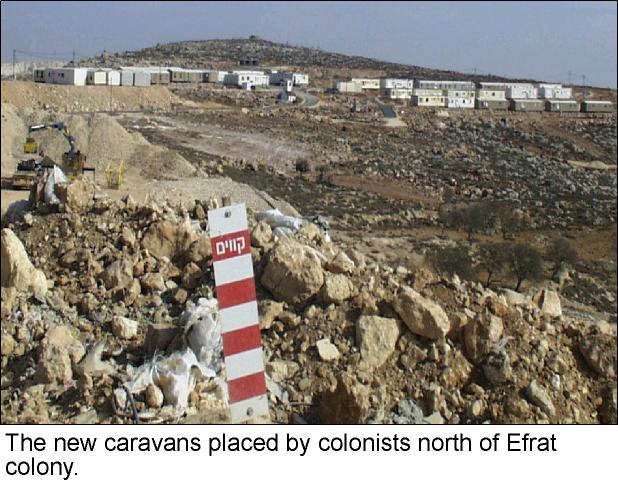Al-Khader village is a small Palestinian village lying at the outskirts of Bethlehem. It is famous for its archaeological sites (most notably the church of Saint George) and its population in1997 was around 7000. Many villagers from Al-Khader rely entirely on agriculture as their source of income and this fact has made them the group that is most vulnerable to Israeli land use policies. Because the lands of Al-Khader lie in close proximity to many Jewish settlements, these lands suffer frequent transgression from settlers as well as from the Israeli authorities.
Location map
On the 28th of November, Israeli authorities went ahead with a demolition campaign in the village of Al-Khader. First, Mohamad Abdel Salam Salah's irrigation pool was demolished. The irrigation pool had cost him over 11,000 Shekels (around $2,600). Not only that, but also in the beginning of that month settlers had destroyed the irrigation pipes serving his land. Mohamad says the pipes cost him around 1,000 Shekels (around $250). To make matters worse, the shortage in rainwater made his dependence on wells more acute. Mohamad added that the cost of maintaining one of his lands this year was 20,000 Shekels (around $4,750) while his produce did not amount to more than 4000-Shekels-worth of crops because of water shortages. He has seven children and lives solely on the revenues of his land.
Mohamad Mahmoud Abdel Salam Salah's demolished irrigation pool.
Further north of that location, Ahmad Khader Salah's shack and well were also demolished. The shack's debris was thrown into the well to insure it is not used again.
Salah's demolished well with the shack debris inside it.
Another victim was Fawzi Jabr Al-Zayah whose 250 m3 well was demolished. This well, which lies just north of Neve Daniyyel settlement, cost him over 20,000 Shekels (around $4,750). One of the villagers who owns a land next to Fawzi mentioned that the other week a settler pointed an M-16 machine gun at him and prohibited him from reaching his own land.
Al-Zayah's 250 m3 well with the settlement of Neve Daniyyel in the background.
Not very far from Fawzi's well lied Mahmoud Salim Sbeih's shack. The shack was also demolished. However, the demolition of the shack resulted in the fracture of the well that lies below the shack thus rendering it useless. The well did not have a demolition order.
Sbeih's demolished shack that resulted in the fracture of the well below it.
On December 6th , Ahmad Tayeh Issa got a demolition ultimatum for his well. Ahmad said that Israeli troops had seen him building it four years ago and did not object then. He added that it is only this year that the Israeli authorities are zealous in their demolition campaign in the area. For the time being, over 30 irrigation pools have demolition ultimatums that are outstanding.
In another incident on November 2nd, settlers stopped a Palestinian land reclamation project in Al-Khader. The project, which is funded by the UNDP with the cooperation of Al-Khader municipality, has parts lying close to the Jewish settlements of Efrat, Elazar, and Neve Daniyyel. The settler clashed with the villagers (injuring some of them) and claimed that the land pertains to the settlements. The villagers said they had the documents to prove their ownership of it and that the Israeli authorities had approved the project earlier (see the blue striped area in map).
Nevertheless, the Israeli authorities that rushed to the scene requested the villagers to work on another section of the project until the problem is solved. For now the villagers are working in a different section (see the brown striped area in map). For their part, the Israeli forces, although acknowledging that the project has been approved by the Israeli ministry of defense, are still preventing the villagers from working in those sections that the settler lay claim to. ). For their part, the Israeli forces, although acknowledging that the project has been approved by the Israeli ministry of defense, are still preventing the villagers from working in those sections that the settler lay claim to.
Moreover, on November 29th , not far from the area of the demolished wells, Israeli authorities (aided with around twenty military vehicles) destroyed Ibrahim Sarafandi's gas-cylinders storehouse. They also destroyed his brother's two-room house that lies next to the storehouse. Before carrying out the demolitions the Israeli authorities declared the area closed, barring journalists and residents entry while bulldozers carried out the demolitions. Al-Sarafandi says the storehouse was built four years ago and at that time the demolition ultimatum was not given by hand. Furthermore, Abdel-Salam Ahmad Al-Seer, whose house lies opposite the storehouse, also received a demolition order on the two new rooms built. The houses and the storehouse lie directly next to a new expansion area north of Efrat settlement where 40 caravans lay. Obviously, the presence of Palestinians next to those caravans is seen as a menace by the Israeli authorities, and thus where slated for demolition.
There are 30 houses in that area threatened with demolition under the pretext of being built in Area 'C' without permits. Nevertheless the chief of the municipality said the area was within Al-Khader's jurisdiction and therefore it should be the only authority to issue permits.
Israel claims it carries out demolition orders only to enforce the law. The structures marked for demolition are those without permits and thus demolishing them is merely an act of law enforcement. Technically that's correct, but practically building permits are seldom given to Palestinians and in the rare cases in which they are given, the procedures undergo endless delays. Israeli zoning plans for Palestinian areas are inadequate and do not address the inhabitants' growth needs, especially in areas adjacent to Jewish settlements. The result of that has been that people would build without permits hoping that in the future a permit would be obtained. The Israeli authorities on the other hand selectively execute demolition orders on those structures that hinder the expansion of Jewish settlements or bypass roads. In the case of the aforementioned wells, four lie next to Efrat settlement and the fifth lies next to Neve Daniyyel. (See map)
Through its demolition policy, Israel is trying to minimize as much as it can Palestinian presence in specific areas of the West Bank. Israeli policy makers aspire to annex those areas to Israel in any final status solution. In the preceding case, the wells and houses lie in the Gush Etzion area, which Israeli politicians have constantly demanded. In spite of Palestinian tenaciousness to their land, house and well demolitions are putting substantial economic, as well as psychological, pressure on the villagers that Israeli schemes may indeed succeed in depopulating parts of the West Bank.
Prepared by:
The Applied Research Institute – Jerusalem


